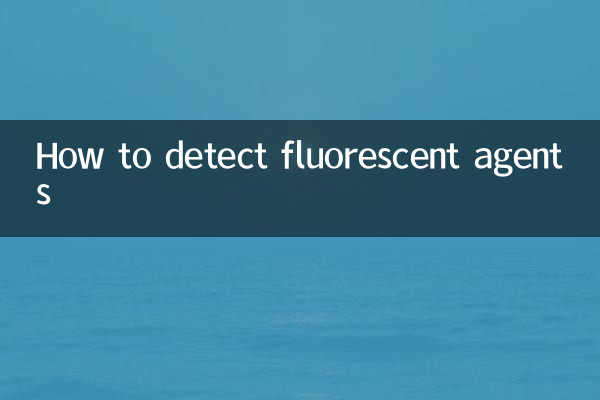How to detect fluorescent agents
In recent years, the safety of fluorescent agents has attracted much attention, especially whether excessive amounts of fluorescent agents are contained in products such as clothing, paper towels, and cosmetics that are closely related to daily life, which has become a hot topic among consumers. This article will combine the popular discussions on the Internet in the past 10 days to introduce you to the detection method of fluorescent agents in detail and provide structured data for reference.
1. What is a fluorescent agent?

Fluorescent Brightener is a chemical substance that absorbs ultraviolet rays and reflects blue light. It is often used in whitening products. Although some fluorescent agents are considered safe, excessive exposure may pose potential risks to skin or health.
2. Common detection methods for fluorescent agents
The following are several fluorescent agent detection methods currently widely used:
| Detection method | Operation steps | Applicable scenarios | Advantages and Disadvantages |
|---|---|---|---|
| UV lamp detection | Place the product under UV light (365nm wavelength) to see if it emits light | Clothing, paper, cosmetics | Quick and convenient, but not quantitative |
| Professional instrument testing | Measure using a spectrophotometer or fluorescence spectrophotometer | laboratory environment | Precise results, high cost |
| Dissolution test method | Dissolve the sample and observe whether the solution glows | liquid or soluble solid | The operation is complicated and requires professional equipment |
3. Simple household testing steps (taking the ultraviolet lamp method as an example)
1. Prepare a UV flashlight with a wavelength of 365nm (ordinary money detector lamp can also be used)
2. Illuminate the item to be tested in a dark environment
3. Observe whether obvious blue-white fluorescence appears
4. The stronger the fluorescence, the higher the fluorescent agent content may be.
4. Reference for test results of fluorescent agents of popular products
According to some product testing data that have been hotly discussed on the Internet recently:
| Product Category | Number of test samples | Fluorescent agent content | average fluorescence intensity |
|---|---|---|---|
| sanitary napkin | 32 | 68% | medium |
| baby wipes | 25 | 12% | weak |
| A4 printing paper | 18 | 100% | strong |
| White T-shirt | 40 | 45% | Moderately weak |
5. Recommendations for safe use of fluorescent agents
1. Choose reputable brand products
2. Avoid direct contact with items that may contain high doses of fluorescent agents
3. It is recommended to wash newly purchased clothes before wearing them.
4. People with sensitive skin should be careful when using cosmetics containing fluorescent agents.
5. Try to choose products without fluorescent agents for infant products.
6. Common misunderstandings about fluorescent agents
Myth 1: All fluorescent agents are toxic
Fact: Only some types of fluorescent agents may be harmful, and only at certain doses
Myth 2: Shining light means danger
Fact: Fluorescence intensity does not directly correspond to toxicity
Myth 3: Natural items do not contain fluorescent agents
Fact: Some natural substances (such as some vitamins) also have fluorescent reactions
7. Recommended by professional testing institutions
If you need accurate testing, you can contact the following organizations:
- National Textile Products Quality Supervision and Inspection Center
- China Inspection and Certification Group
- SGS-CSTC Standards Technical Services Co., Ltd.
Conclusion: Although fluorescent agent detection is simple, the detection results need to be viewed rationally. It is recommended that consumers not only pay attention to product safety, but also understand relevant scientific knowledge to avoid unnecessary panic. The best way to protect your health is to choose formal channels to purchase goods and pay attention to the ingredient labels of the products.

check the details

check the details